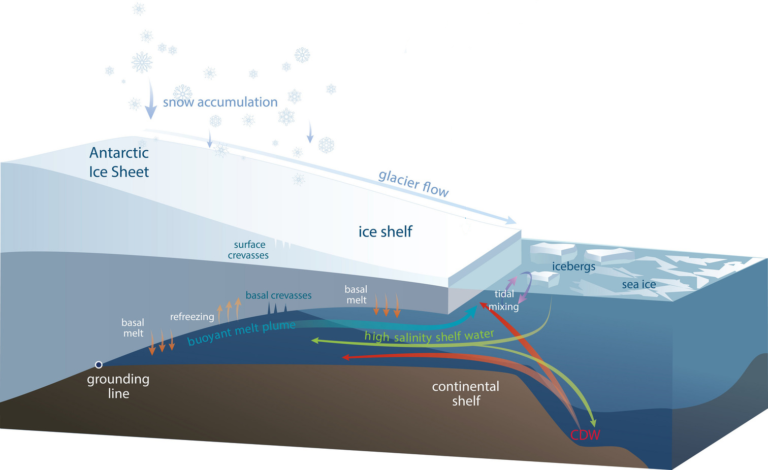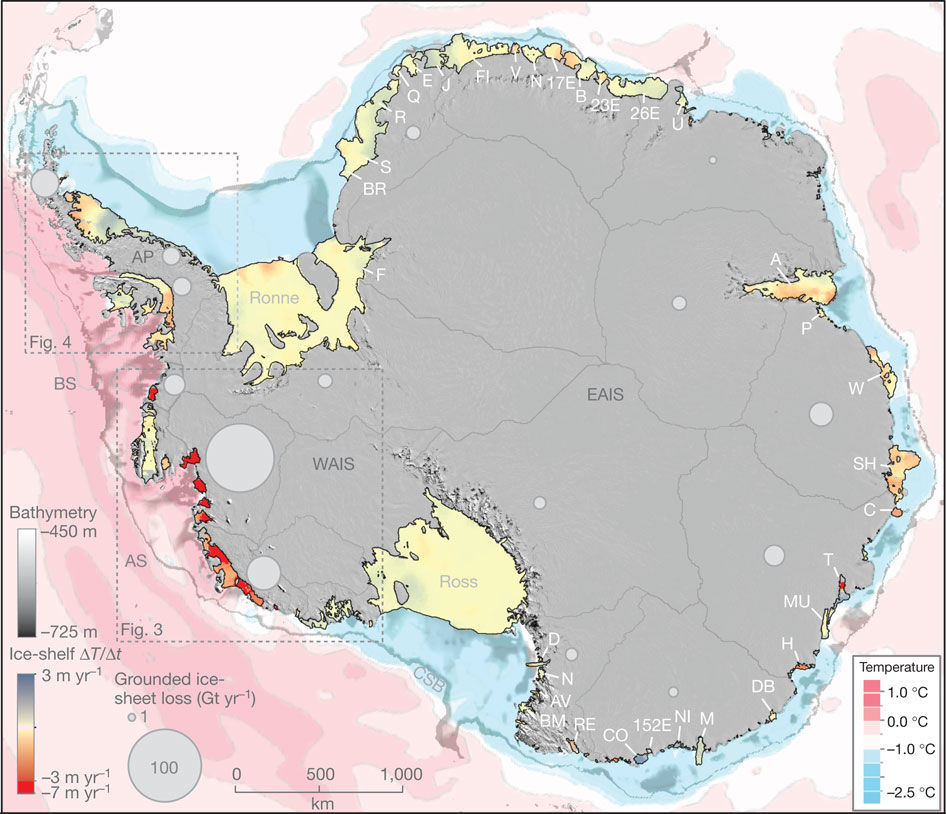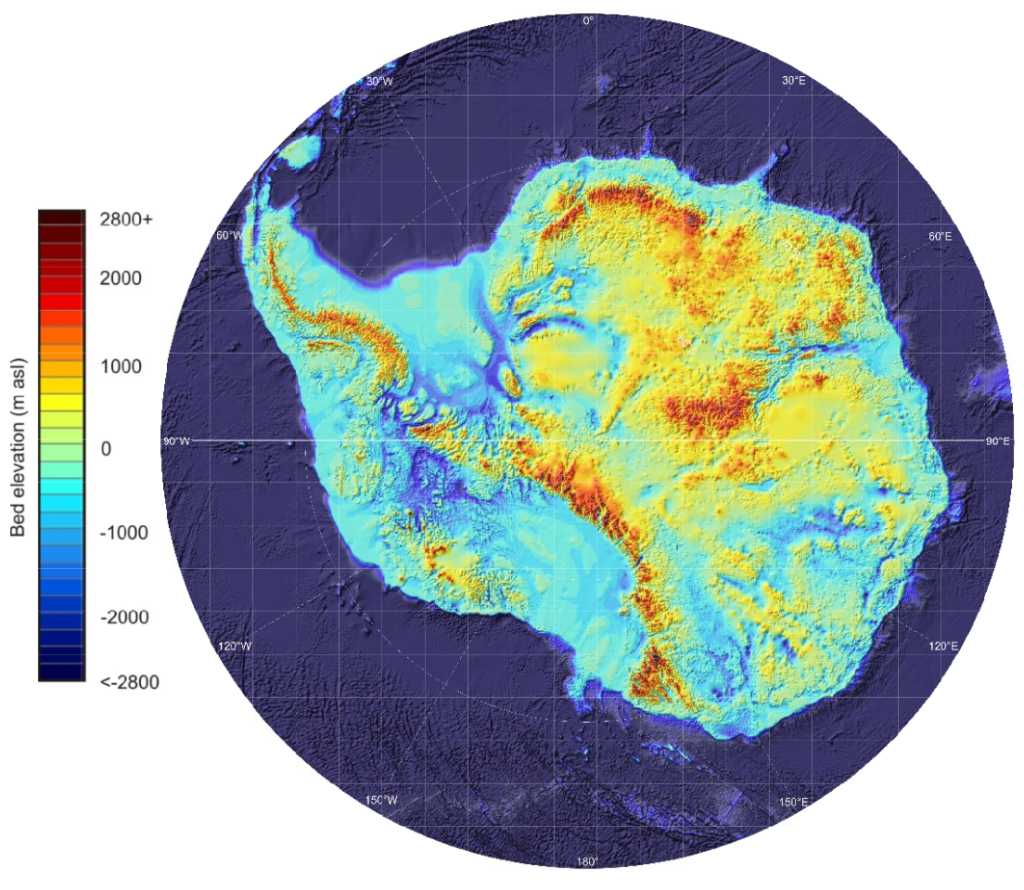The Antarctic Ice Sheet is melting because it is losing more mass through increased air and ocean temperatures than it gains mass by snow fall. Melting of ice is most efficient through contact with water, because water has a higher heat conductivity compared to air; simply said this means that water removes heat easier from the ice than air. In case of the Antarctic Ice Sheet it is also of importance that air temperatures are mainly far below the freezing point, whereas the ocean is always warmer than or close to the freezing point. The strongest melting in Antarctica therefore occurs beneath ice shelves. You want to know more about the melting process and what happens beneath an ice shelf?
The ice pump beneath ice shelves
Ice shelves are melting from beneath as ocean water reaches into the cavity. To explain the processes, we come back to the sketch of an ice shelf that we already showed you before.
In front of ice shelves the ocean freezes to sea ice, which is a process that produces very saline and dense water (high salinity shelf water). Because of its high density, it sinks down and mixes with circumpolar deep water (CDW) that spills over the continental shelf edge. The water mixture is then relatively dense and warm. It flows along the bottom of the continental shelf that is—in many cases—deepening inland and therefore reaches far beneath the ice shelf. When the water reaches to the ice shelf base it is far below sea level and at a higher pressure. Water there can still be liquid at temperatures down to below -2⁰C! And the ice starts melting as soon as the temperatures reach above this pressure melting point! If the ocean water is warmer than this temperature, it melts the ice shelf from below. The melt water is fresh with a low density and brings water out of the ice shelf cavity in form of a buoyant melt plume. All together, this forms an ocean circulation beneath the ice shelf, called ice pump.

Where does the warm water come from?
The rates at which all Antarctic ice shelves melt from beneath are estimated to be about 1325 Gt/yr (gigatons per year; or 3.7 mm sea level equivalent per year). Yes, this is a lot! We are wondering where all the energy comes from and how the warm water reaches onto the continental shelf…
The dynamics governing the flow of warm water towards and underneath the ice shelves are non-trivial and still poorly understood. However, we know that the heat reservoir threatening the ice shelves is located off the continental shelf, in the deep Southern Ocean, where relatively warm water resides below a shallow, cold and fresh surface layer. Well, you may wonder how cold water can float on top of warm water!? If you have ever been swimming in a lake or in the ocean, you may have realized that it usually gets colder the further down you get.
Water layers in the oceans are stratified due to their different densities, with the densest water masses lying at the bottom of the sea floor and the lightest water masses floating at the surface. Density is given by the salt content and the temperature: high salinity and low temperatures lead to the densest water masses. In the tropics, the temperature is more important and it usually gets colder with depth. Closer to the poles, however, salinity gets more important. In the Southern Ocean, the warmer water can stay beneath the cold and fresh surface layer, because of its high salt concentration. The warm subsurface water it transported with the Antarctic slope current, which flows westwards along the Antarctic slope almost around the whole Antarctic continent.
West Antarctic threatened by a warm ocean
In West Antarctic, especially in the Amundsen and the Bellinghausen Sea, the water found on the continental shelf is relatively warm compared to East Antarctic (Figure 5), resulting in high melt at the base of the ice shelves. Some of the ice shelves therefore thin tens of meters per decade! This thinning also expands upstream to the proximal grounded glaciers which then causes a sea level rise. The figure shows that already today one drainage area in West Antarctica alone lost almost 100 Gt/yr to the ocean, with a trend towards increasing numbers due to basal malt. These basal melt rates are challenging to estimate, which makes the contribution of West Antarctic Ice Sheet melt to sea level rise to the largest source of uncertainty in the fifth assessment report of the Intergovernmental Panel on Climate Change (IPCC).

West Antarctic – A marine ice sheet
Besides the ocean temperatures, there is another substantial difference between West and East Antarctica that leads to the high mass loss in the former one: The bedrock beneath the West Antarctic Ice Sheet lies far below sea level (up to more than 1 km) in most parts (the blue areas in Figure 6). Thus, most of the ice sheet’s base is located far below sea level, what we call a marine ice sheet. Marine ice sheets are particularly instable for several reasons:
- Their bed slopes inland, which generally is an instable configuration. As submarine melt moves the grounding line—the transition zone between grounded and floating ice—further inland, it reaches into deeper areas, that make the glacier floating again and also causes a larger flux through the grounding line. Once this process is triggered, the glacier retreats continuously until the bed geometry changes again.
- The pressure melting point—the temperature at which ice freezes or melts—is reduced when the pressure increases. When the glacier base reaches into deeper waters where the pressure is higher, the melting point therefore decreases and the surrounding water is warm relative to the melting point. It may be warm enough to melt the ice from below.
The uncertainty regarding the West Antarctic Ice Sheet melt to sea level rise therefore results from the exposure of the ice sheet to relatively warm water. The ice sheet is also close to a tipping point at which the ice sheet may irreversibly lose large amounts of ice. To better estimate future sea level rise, we need a good estimate on the ocean heat flux to the ice shelves and good knowledge on the response of the ice sheet.


The underside of the ice shelves has turned to slush – this is why the ice shelves are breaking into pieces at record rates. The slush is the result of heat coming up from the underwater volcanoes – dozens of them – under the ice shelves. Sea ice is insanely low too.
Since the rapidly-melting ice shelves hold the WAIS in place, and since the WAIS extends up over four km above sea level, since the underside of the glaciers have melted into cascading waterfalls that are racing down the mountains and slamming into the ice shelves … what happens next is physics.
The members of my international research group have already re-located to various relatively-safe locations. We don’t know when the collapse will happen but we know what happened the last time the Antarctic ice was pulverized by colossal tsunami waves so we’re not taking chances.
Thank you. Just enter your e-mail address on the first page of the blog and you’ll be notified when there is a new post.